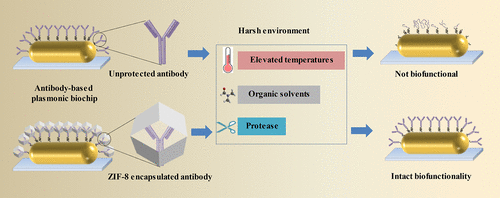Our official English website, www.x-mol.net, welcomes your feedback! (Note: you will need to create a separate account there.)
Ultrarobust Biochips with Metal–Organic Framework Coating for Point-of-Care Diagnosis
ACS Sensors ( IF 8.9 ) Pub Date : 2018-01-30 00:00:00 , DOI: 10.1021/acssensors.7b00762 Congzhou Wang 1 , Lu Wang 1 , Sirimuvva Tadepalli 1 , Jeremiah J. Morrissey 2, 3 , Evan D. Kharasch 2, 3, 4 , Rajesh R. Naik 5 , Srikanth Singamaneni 1
ACS Sensors ( IF 8.9 ) Pub Date : 2018-01-30 00:00:00 , DOI: 10.1021/acssensors.7b00762 Congzhou Wang 1 , Lu Wang 1 , Sirimuvva Tadepalli 1 , Jeremiah J. Morrissey 2, 3 , Evan D. Kharasch 2, 3, 4 , Rajesh R. Naik 5 , Srikanth Singamaneni 1
Affiliation

|
Most biosensors relying on antibodies as recognition elements fail in harsh environment conditions such as elevated temperatures, organic solvents, or proteases because of antibody denaturation, and require strict storage conditions with defined shelf life, thus limiting their applications in point-of-care and resource-limited settings. Here, a metal–organic framework (MOF) encapsulation is utilized to preserve the biofunctionality of antibodies conjugated to nanotransducers. This study investigates several parameters of MOF coating (including growth time, surface morphology, thickness, and precursor concentrations) that determine the preservation efficacy against different protein denaturing conditions in both dry and wet environments. A plasmonic biosensor based on gold nanorods as the nanotransducers is employed as a model biodiagnostic platform. The preservation efficacy attained through MOF encapsulation is compared to two other commonly employed materials (sucrose and silk fibroin). The results show that MOF coating outperforms sucrose and silk fibroin coatings under several harsh conditions including high temperature (80 °C), dimethylformamide, and protease solution, owing to complete encapsulation, stability in wet environment and ease of removal at point-of-use by the MOF. We believe this study will broaden the applicability of this universal approach for preserving different types of on-chip biodiagnostic reagents and biosensors/bioassays, thus extending the benefits of advanced diagnostic technologies in resource-limited settings.
中文翻译:

具有金属有机骨架涂层的超健壮生物芯片可用于即时诊断。
大多数依赖抗体作为识别元件的生物传感器由于抗体变性而在苛刻的环境条件(例如高温,有机溶剂或蛋白酶)中失效,并且需要严格的储存条件并具有明确的保存期限,因此限制了它们在即时诊疗和资源中的应用限制的设置。在这里,金属有机框架(MOF)封装被用来保留与纳米传感器结合的抗体的生物功能。这项研究调查了MOF涂层的几个参数(包括生长时间,表面形态,厚度和前体浓度),这些参数确定了在干燥和潮湿环境中针对不同蛋白质变性条件的保存效果。基于金纳米棒作为纳米换能器的等离子体生物传感器被用作模型生物诊断平台。将通过MOF封装获得的保存功效与其他两种常用材料(蔗糖和丝素蛋白)进行了比较。结果表明,在完全苛刻的条件下(在80°C),二甲基甲酰胺和蛋白酶溶液等苛刻条件下,MOF涂层的性能优于蔗糖和丝素蛋白涂层,这归因于其完全的封装,在潮湿环境中的稳定性以及在使用时易于去除的特点。由财政部。我们相信,这项研究将拓宽这种通用方法在保留不同类型的芯片上生物诊断试剂和生物传感器/生物测定法方面的适用性,从而在资源有限的环境中扩展先进诊断技术的优势。将通过MOF封装获得的保存功效与其他两种常用材料(蔗糖和丝素蛋白)进行了比较。结果表明,在完全苛刻的条件下(在80°C),二甲基甲酰胺和蛋白酶溶液等苛刻条件下,MOF涂层的性能优于蔗糖和丝素蛋白涂层,这归因于其完全的封装性,在潮湿环境中的稳定性以及在使用时易于去除的特点。由财政部。我们相信,这项研究将拓宽这种通用方法在保留不同类型的芯片上生物诊断试剂和生物传感器/生物测定法方面的适用性,从而在资源有限的环境中扩展先进诊断技术的优势。将通过MOF封装获得的保存功效与其他两种常用材料(蔗糖和丝素蛋白)进行了比较。结果表明,在完全苛刻的条件下(在80°C),二甲基甲酰胺和蛋白酶溶液等苛刻条件下,MOF涂层的性能优于蔗糖和丝素蛋白涂层,这归因于其完全的封装性,在潮湿环境中的稳定性以及在使用时易于去除的特点。由财政部。我们相信,这项研究将拓宽这种通用方法在保留不同类型的芯片上生物诊断试剂和生物传感器/生物测定法方面的适用性,从而在资源有限的环境中扩展先进诊断技术的优势。结果表明,在完全苛刻的条件下(在80°C),二甲基甲酰胺和蛋白酶溶液等苛刻条件下,MOF涂层的性能优于蔗糖和丝素蛋白涂层,这归因于其完全的封装性,在潮湿环境中的稳定性以及在使用时易于去除的特点。由财政部。我们相信,这项研究将拓宽这种通用方法在保留不同类型的芯片上生物诊断试剂和生物传感器/生物测定法方面的适用性,从而在资源有限的环境中扩展先进诊断技术的优势。结果表明,在完全苛刻的条件下(在80°C),二甲基甲酰胺和蛋白酶溶液等苛刻条件下,MOF涂层的性能优于蔗糖和丝素蛋白涂层,这归因于其完全的封装性,在潮湿环境中的稳定性以及在使用时易于去除的特点。由财政部。我们相信,这项研究将拓宽这种通用方法在保留不同类型的芯片上生物诊断试剂和生物传感器/生物测定法方面的适用性,从而在资源有限的环境中扩展先进诊断技术的优势。
更新日期:2018-01-30
中文翻译:

具有金属有机骨架涂层的超健壮生物芯片可用于即时诊断。
大多数依赖抗体作为识别元件的生物传感器由于抗体变性而在苛刻的环境条件(例如高温,有机溶剂或蛋白酶)中失效,并且需要严格的储存条件并具有明确的保存期限,因此限制了它们在即时诊疗和资源中的应用限制的设置。在这里,金属有机框架(MOF)封装被用来保留与纳米传感器结合的抗体的生物功能。这项研究调查了MOF涂层的几个参数(包括生长时间,表面形态,厚度和前体浓度),这些参数确定了在干燥和潮湿环境中针对不同蛋白质变性条件的保存效果。基于金纳米棒作为纳米换能器的等离子体生物传感器被用作模型生物诊断平台。将通过MOF封装获得的保存功效与其他两种常用材料(蔗糖和丝素蛋白)进行了比较。结果表明,在完全苛刻的条件下(在80°C),二甲基甲酰胺和蛋白酶溶液等苛刻条件下,MOF涂层的性能优于蔗糖和丝素蛋白涂层,这归因于其完全的封装,在潮湿环境中的稳定性以及在使用时易于去除的特点。由财政部。我们相信,这项研究将拓宽这种通用方法在保留不同类型的芯片上生物诊断试剂和生物传感器/生物测定法方面的适用性,从而在资源有限的环境中扩展先进诊断技术的优势。将通过MOF封装获得的保存功效与其他两种常用材料(蔗糖和丝素蛋白)进行了比较。结果表明,在完全苛刻的条件下(在80°C),二甲基甲酰胺和蛋白酶溶液等苛刻条件下,MOF涂层的性能优于蔗糖和丝素蛋白涂层,这归因于其完全的封装性,在潮湿环境中的稳定性以及在使用时易于去除的特点。由财政部。我们相信,这项研究将拓宽这种通用方法在保留不同类型的芯片上生物诊断试剂和生物传感器/生物测定法方面的适用性,从而在资源有限的环境中扩展先进诊断技术的优势。将通过MOF封装获得的保存功效与其他两种常用材料(蔗糖和丝素蛋白)进行了比较。结果表明,在完全苛刻的条件下(在80°C),二甲基甲酰胺和蛋白酶溶液等苛刻条件下,MOF涂层的性能优于蔗糖和丝素蛋白涂层,这归因于其完全的封装性,在潮湿环境中的稳定性以及在使用时易于去除的特点。由财政部。我们相信,这项研究将拓宽这种通用方法在保留不同类型的芯片上生物诊断试剂和生物传感器/生物测定法方面的适用性,从而在资源有限的环境中扩展先进诊断技术的优势。结果表明,在完全苛刻的条件下(在80°C),二甲基甲酰胺和蛋白酶溶液等苛刻条件下,MOF涂层的性能优于蔗糖和丝素蛋白涂层,这归因于其完全的封装性,在潮湿环境中的稳定性以及在使用时易于去除的特点。由财政部。我们相信,这项研究将拓宽这种通用方法在保留不同类型的芯片上生物诊断试剂和生物传感器/生物测定法方面的适用性,从而在资源有限的环境中扩展先进诊断技术的优势。结果表明,在完全苛刻的条件下(在80°C),二甲基甲酰胺和蛋白酶溶液等苛刻条件下,MOF涂层的性能优于蔗糖和丝素蛋白涂层,这归因于其完全的封装性,在潮湿环境中的稳定性以及在使用时易于去除的特点。由财政部。我们相信,这项研究将拓宽这种通用方法在保留不同类型的芯片上生物诊断试剂和生物传感器/生物测定法方面的适用性,从而在资源有限的环境中扩展先进诊断技术的优势。



























 京公网安备 11010802027423号
京公网安备 11010802027423号